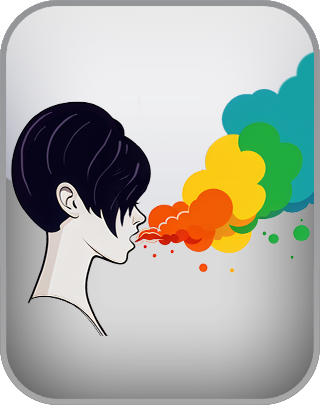Academically reviewed by Dr. Sabina Alispahić, Ph.D., professor of psychology
Grapheme-Color Synesthesia Test
Synesthesia is a neurological condition where stimulating one sensory or cognitive pathway leads to automatic and involuntary experiences in another. This means that individuals with synesthesia might perceive a blending of senses; for example, hearing sounds might cause them to see colors. Synesthetic experiences are automatic, consistent, and involuntary, occurring without conscious effort and remaining stable over time.
While the exact cause of synesthesia is unclear, it is thought to involve increased connectivity between brain regions, and it often runs in families, suggesting a genetic component. Synesthesia is not considered a disorder but rather a variation in perception, with many synesthetes finding their experiences enriching and beneficial for memory and creativity.
One type of synesthesia is grapheme-color synesthesia, where letters and numbers are perceived as colored. This test will determine whether you have grapheme-color synesthesia.
Question 1 of 35
What color do you associate with or experience when you see?
2
NEXT
The IDRlabs Grapheme-Color Synesthesia Test was based on David Eagleman’s “The Synesthesia Battery” and developed by IDRlabs.
Grapheme-color synesthesia is a fascinating neurological condition where individuals associate specific letters or numbers with distinct colors. For those with this type of synesthesia, the experience of reading or thinking about a letter or number is automatically linked to a consistent color perception. For instance, the letter 'A' might always appear red, while the number '7' might be seen as green. This phenomenon occurs involuntarily and remains stable over time, offering a unique window into the complex interplay between sensory modalities in the brain.
The underlying mechanism of grapheme-color synesthesia involves atypical neural connections between the brain's regions responsible for processing visual input (such as letters and numbers) and those involved in color perception. Research suggests that these cross-activations occur due to increased connectivity or communication between the visual cortex and the color-processing areas. Functional MRI studies have shown that synesthetes exhibit heightened activity in both regions when viewing graphemes, indicating that these parts of the brain are more interconnected than in non-synesthetes.
Individuals with grapheme-color synesthesia often report certain cognitive and perceptual benefits. The additional layer of color association can enhance memory and recall, as the unique color attributes provide extra mnemonic cues. This can be particularly advantageous in tasks involving complex information processing, such as learning languages or remembering numerical sequences. Moreover, synesthetes may experience a richer, more vivid perceptual world, as their sensory experiences are imbued with an additional dimension of color.
Despite its intriguing benefits, grapheme-color synesthesia can also pose challenges. The automatic and involuntary nature of the color associations can be distracting, especially in environments where the actual colors of text or numbers conflict with the synesthetic colors. This can lead to difficulties in tasks requiring focused attention or in settings where precise color recognition is critical.
As the publishers of this free test, which allows you to screen yourself for the characteristics of grapheme-color synesthesia, we have strived to make the test as reliable and valid as possible by subjecting this test to statistical controls and validation. However, free online quizzes such as the present test do not provide professional assessments or recommendations of any kind; the test is provided entirely “as-is.” For more information about any of our online tests and quizzes, please consult our Terms of Service.

